Cultural Differences in Interpreting and Coping Tactics 口译中的文化差异及应对策略
对文化不同的看法英语作文
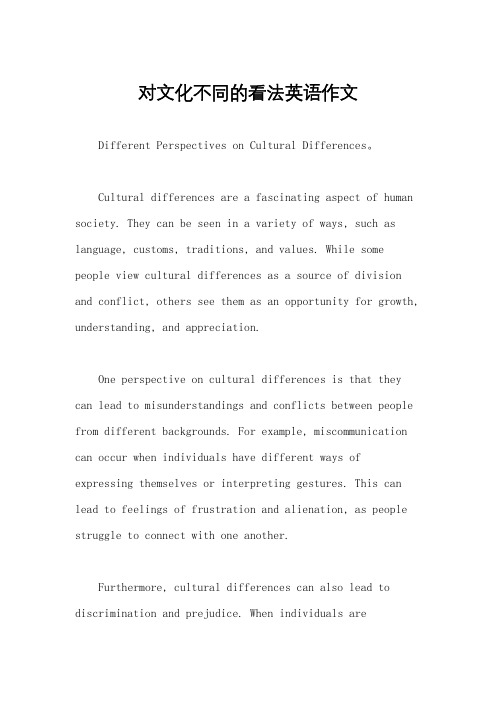
对文化不同的看法英语作文Different Perspectives on Cultural Differences。
Cultural differences are a fascinating aspect of human society. They can be seen in a variety of ways, such as language, customs, traditions, and values. While some people view cultural differences as a source of division and conflict, others see them as an opportunity for growth, understanding, and appreciation.One perspective on cultural differences is that they can lead to misunderstandings and conflicts between people from different backgrounds. For example, miscommunication can occur when individuals have different ways of expressing themselves or interpreting gestures. This can lead to feelings of frustration and alienation, as people struggle to connect with one another.Furthermore, cultural differences can also lead to discrimination and prejudice. When individuals areunfamiliar with a particular culture, they may make assumptions or stereotypes based on limited information. This can result in unfair treatment and marginalization of certain groups, perpetuating a cycle of inequality and division.On the other hand, there are those who see cultural differences as a valuable and enriching part of human experience. They believe that diversity is a strength, not a weakness, and that it should be celebrated and embraced. By learning about different cultures, individuals can broaden their perspectives, challenge their assumptions, and develop empathy and understanding for others.Moreover, cultural differences can also lead to innovation and creativity. When people from different backgrounds come together, they bring unique perspectives and ideas that can spark new ways of thinking and problem-solving. This can lead to collaboration and cooperation, as individuals work together to find common ground and create something truly remarkable.In conclusion, cultural differences are a complex and multifaceted aspect of human society. While they can lead to misunderstandings and conflicts, they can also be a source of growth, understanding, and appreciation. By approaching cultural differences with an open mind and a willingness to learn, individuals can bridge divides, foster connections, and create a more inclusive and harmonious world.。
高中英语body language
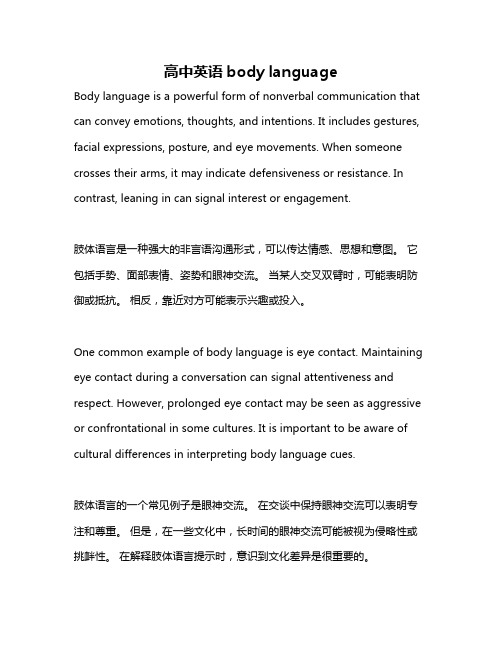
高中英语body languageBody language is a powerful form of nonverbal communication that can convey emotions, thoughts, and intentions. It includes gestures, facial expressions, posture, and eye movements. When someone crosses their arms, it may indicate defensiveness or resistance. In contrast, leaning in can signal interest or engagement.肢体语言是一种强大的非言语沟通形式,可以传达情感、思想和意图。
它包括手势、面部表情、姿势和眼神交流。
当某人交叉双臂时,可能表明防御或抵抗。
相反,靠近对方可能表示兴趣或投入。
One common example of body language is eye contact. Maintaining eye contact during a conversation can signal attentiveness and respect. However, prolonged eye contact may be seen as aggressive or confrontational in some cultures. It is important to be aware of cultural differences in interpreting body language cues.肢体语言的一个常见例子是眼神交流。
在交谈中保持眼神交流可以表明专注和尊重。
但是,在一些文化中,长时间的眼神交流可能被视为侵略性或挑衅性。
在解释肢体语言提示时,意识到文化差异是很重要的。
文化差异导致的思维方式不同的英语作文

文化差异导致的思维方式不同的英语作文Culture is deeply ingrained in every aspect of human life, including language and thinking. The differences in cultural background often result in varying ways of thinking and interpreting the world.文化深深扎根于人类生活的方方面面,包括语言和思维方式。
不同的文化背景往往导致了不同的思考方式和对世界的解读。
In terms of language, cultural differences can be observed in the use of words, expressions, and even nonverbal communication. For example, the English language places a strong emphasis on politeness and indirectness, while Chinese language often values modesty and humility.在语言方面,文化差异可以体现在词汇的使用,表达方式甚至非言语交流上。
比如,英语语言在礼貌和委婉上有着很强的重视,而汉语常常强调谦虚和谦逊。
Furthermore, the concept of time varies greatly across different cultures. In Western cultures, time is often viewed as a commoditythat needs to be used efficiently, while in many Eastern cultures, time is perceived more fluidly and less rigidly.此外,时间的概念在不同的文化中有着很大的差异。
中西方文化差异的论文题目

中西方文化差异的论文题目:中西方时间观念的比较中西方饮食文化的比较中西方教育的比较中西方问候语的比较中西方餐桌礼仪的差异中西方宗教文化对比中西方儿童文学的差异从文字比较看中西方文化差异礼貌中的中西方“面子文化”差异论中西方激励机制的差异比较和在医疗管理中的应用英语教学中的文化教学——中西方文化差异对比分析中西方价值观差异对交际模式的影响从历史中透视中西方经济差异形成的原因浅谈跨越中西方文化障碍日常生活中的中西方文化差异浅析中西方隐私观的差异中西方古代体育和谐思想比较研究中西方传统犯罪控制思想之比较土地与海洋的对话——中西方文化与人格差异之浅见汉英商标翻译与中西方文化差异中西方孝文化探析从文化视角看中西方教育思想的差异中西方语言与文化的差异中西方哲学语言观的差异浅析中西方文化差异对翻译的影响从素质教育看中西方教育的差异及思考中西方立宪文化差异比较——以价值观为视角影响跨文化交际的主要因素——中西方价值观念差异中西方股票期权制度实际操作的差异性分析英语词汇学论文论文题目英语语言的特征试论英语逆序构词法论英语主谓一致The Change of English word Meaning:Factors and Types英语词汇意义变化的影响因素与类型运用“发散思维”来扩大学生的词汇量现代英语词汇迅速发展的源泉网络英语的词汇类型及其特点广告英语的词汇特点英语教学中词汇的处理英语词汇意义的特点与词汇教学论中英文中动物词汇的文化差异英汉文化内涵在动物词汇上的体现试论篇章词汇衔接的语义基础英汉词汇文化内涵探析女性相关词汇及其文化内涵动物词汇的应用及其隐喻性的探索就词汇空缺谈旅游英语翻译技巧汉英语姓名文化对比研究英语颜色词的词义及文化对比研究论提高大学英语词汇教学浅析词汇的记忆与词的形态理据之问的关系试析英语中的歧义现象大学英语词汇教学的有效方法2095 英语词汇教学新探英语词汇的联想与搭配探析英汉词汇比较中文化内涵的展现英汉词汇的文化差异隐喻对英语词汇演变的影响隐喻认知理论对英语词汇教学的启示论英语词汇搭配的特征言语听辨中的词汇提取英语词汇的认知与活用英美社会与文化论文1. The Contrast and Analyses of Customs in Britain and China英国和中国习俗之研究2. Cultural Connotation of English Names英语姓名的文化内涵3. Black Culture and American English黑人文化与美国英语4. The Phenomenon of “Political Correctness” in American English 论美国英语中的政治正确现象5. English Euphemism and Culture文化因素与委婉语6. Cultural Differences in Address Terms: English and Chinese英汉称呼语中的文化差异7.Influence of Greek Myths to British and American Culture希腊神话与英美文化8. An Investigation on Intercultural Communication Competence and Intercultural Sensitivity Among Chinese College Students关于中国大学生跨文化交际能力和跨文化敏感度的调查9. Cross-Cultural Awareness in Translating Tourist Materials中国旅游资料翻译中的跨文化意识10. Cross-Cultural Training in Chinese Universities中国大学中的跨文化培训11. Acculturation Strategies among Chinese Overseas Students中国海外留学生的文化适应策略12. On Tour Commentary Translation---An Intercultural Communication Perspective从跨文化角度看导游词翻译13. Intercultural Communication on the Internet互联网上的跨文化交际14. On the Application of Theatrical Tricks to the Shakespeare’s Dramas论莎士比亚戏剧中的舞台技巧的应用15. The Bible and Western Festivals《圣经》与西方节日16. On Culture-loaded Animal Words in Cross-Cultural Communication跨文化交际中的动物文化词研究17. The Cultural Differences Between Chinese and English from the Cultural Attached Meaning of Animal Words从动物词汇看汉英文化的差异18. On Plants Words and Culture论植物词汇与文化19. On the Cultural Connotations of Color Words in English and Chinese中英颜色词文化内涵研究20. Cross-cultural Communication on the Translation of the Chinese “Long”从中国“龙”字的翻译看跨文化交际21. On English and the Chinese Borrowing Words and the Cultural Differences论中英借用词与文化差异22. A Contrast of the Symbols of American and Chinese Culture中美文化象征比较研究23. The Contrastive Study on the Courteous Expressions in English and Chinese英汉礼貌用语对比研究24. Body Language in Non-verbal Communication浅谈非语言交际中的身势语25. Culture Consciousness in the English Language Teaching英语教学中的文化意识26. Reinforcing Equality in Cultural Communication in Cross-cultural Communication跨文化交际应加强文化平等交流意识27. Cross-cultural Difference on the Non-verbal Communication非言语交际的跨文化差异28. Improper Cultural Transferences in Cross-Cultural Communication文化负迁移对跨文化交际的影响29. On Cross-Cultural Communication Phenomenon论跨文化交际现象30. The Difference of Cultural Thinking Between English and Chinese and the Intercultural Communication英汉文化思维差异与跨文化交流31. Chief Factors Affecting Cross-Cultural Communication--- Difference Between Chinese and Western Values影响跨文化交际的主要因素---中西方价值观念差异32. Taboos in Cross-Cultural Communication--- Probing into the Difference Between Western and Chinese Culture跨文化交际中的禁忌问题---中西方文化差异之探讨33. Cultural Differences in Cross-Cultural Communication Between Chinese and English Language谈英汉跨文化交际中的文化差异34. The Difference of the Eastern and Western Mode of Thinking and Cross-Cultural Communication中西思维模式差异与跨文化差异35. Cross-Cultural Communication in Interpretation口译中的跨文化交流36. The Cultural Perception and Memory in Intercultural Communication跨文化交流中的文化感知和文化记忆37.Cultural Factors of English Catchwords英语流行语的文化因素38.The Epitome of Contemporary American History and Culture--- Interpreting Forrest Gump 当代美国历史和文化的缩影---解读《阿甘正传》39. Body Language in Non-verbal Communication浅谈非语言交际中的身势语40. Differences and Resources of Addressing in English英汉语中称谓的差异及其成因41. Cultural Interpretations of English and Chinese Names英汉姓名的文化阐释42. Different Body Languages in Different Cultures身势语在不同文化下的差异43. Functions of Non-verbal Behavior in Intercultural Communication非言语行为在跨文化交际中的功能44. The Contrastive Study on the Courteous Expressions in English and Chinese英汉礼貌用语对比研究45. The Presentation of Different Thinking Modes in Chinese and Western Religious Cultures 中西方宗教文化中的不同思维模式46. The Breath of American Slang美国俚语初探47. The Influences of Western Festivals on Chinese Society西方节日对中国社会的影响48. Cultural Migration of Western Festivals西方节日的文化入侵49. The Influence of Borrowing Words on English and Chinese V ocabulary英汉词语互借对语言文化的影响50.Cross-Cultural Communication in Business World商务领域跨文化现象51.Christianity and American Culture基督教与美国文化52. The Studies of Chinese Movies and Culture中国电影与文化53. Cultural Implication of Chinese Cuisine中国饮食文化的内涵54. Diversities of Chinese and Western Culture from the Sources of English and Chinese Idioms从汉英习语来源看中西方文化的差异55. The Social Status of the Blacks in America after the Civil War美国内战后的黑人社会地位56. A Comparison of Garments Culture between the East and the West中西服饰文化对比57. A Research on Cross-Cultural Difficulties in Reading Comprehension影响阅读理解的跨文化因素研究58. The Reasons of Ancient Greek Mythology Influencing the English Language古希腊神话故事对英语语言影响的原因59. A Cultural Perspective on Chinese and Western Trademarks中西方商标的文化视角60.English Idioms and the Western Culture英语习语和西方文化61. A Tentative Study on English and Chinese Euphemism汉英委婉语研究62.American Place Names and Their Culture美国地名和文化63.A Comparison of Courtesy Conventions between Chinese and English汉英礼貌用语的异同64.Animal Words in Chinese and English Idioms and Their Translations中英习语动物词异同及其翻译65. Cultural Differences on Etiquette between China and Western Countries中西方礼仪文化差异66.Increasing Cultural Awareness of Secondary School Students如何提升中学生的文化意识67.A Comparative Study of Compliments: Cross-Culture Perspectives从跨文化的角度对比中西方问候语的差异英语专业论文题目4跨文化研究•包括中西文化对比(语言,宗教,价值观,物质文化,企业文化,风俗习惯, 教育等). •E.g.•多元文化背景下的美国课程改革•不同文化对于涉及动物的语言的影响•跨文化非言语交际的功能及文化基础•中美儿童教育之比较•中国与西方国家的酒文化•全球电视文化一体化与中国的对策•The Management for Multinational Enterprises in China: Converting Cultural Clash into Introjection•Suggestions for Successful Intercultural Communication in the Process of Sp oken English •Cultural Differences and Translation of the English-Chinese Idioms•The Importance for International Enterprises of Understanding the Diversity of U.S. Culture •The Importance of Understanding the Cultural Characteristic in International Adv ertising。
非语言交流英文作文英语
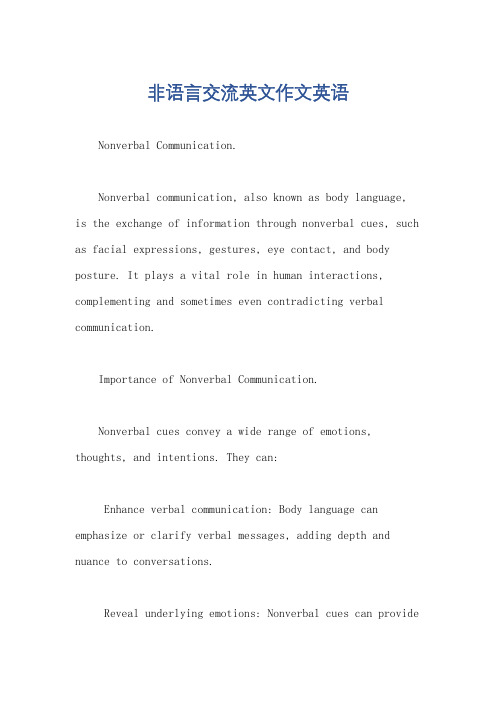
非语言交流英文作文英语Nonverbal Communication.Nonverbal communication, also known as body language, is the exchange of information through nonverbal cues, such as facial expressions, gestures, eye contact, and body posture. It plays a vital role in human interactions, complementing and sometimes even contradicting verbal communication.Importance of Nonverbal Communication.Nonverbal cues convey a wide range of emotions, thoughts, and intentions. They can:Enhance verbal communication: Body language can emphasize or clarify verbal messages, adding depth and nuance to conversations.Reveal underlying emotions: Nonverbal cues can provideinsights into a person's true feelings, even when they tryto conceal them verbally.Build rapport and trust: Positive nonverbal cues, such as open gestures and warm facial expressions, can foster trust and connection between individuals.Negotiate social interactions: Body language can help establish social boundaries, regulate turn-taking, and convey dominance or submission.Types of Nonverbal Cues.Facial expressions: The face is the most expressivepart of the body, capable of conveying a myriad of emotions. Facial muscle movements can indicate happiness, sadness, anger, fear, surprise, and disgust.Gestures: Hand and body gestures can convey a wide range of meanings, from simple acknowledgments to complex cultural symbols. For example, a thumbs-up gesture can indicate approval in Western societies, but it may beconsidered offensive in some other cultures.Eye contact: Eye contact plays a crucial role in communication. Direct eye contact can convey confidence, interest, and engagement, while avoiding eye contact can indicate avoidance or discomfort.Body posture: The way a person holds their body can reveal their emotional state, social status, and level of confidence. Open and relaxed postures tend to convey openness and approachability, while closed and defensive postures may indicate anxiety or hostility.Cultural Variations in Nonverbal Communication.Nonverbal communication is not universal and can vary significantly across cultures. For instance, what may be considered a polite gesture in one culture could be offensive in another. It is essential to be aware of cultural differences when interpreting nonverbal cues to avoid misunderstandings.Improving Nonverbal Communication Skills.Effective nonverbal communication requires practice and self-awareness. Here are some tips for improving your nonverbal skills:Pay attention to your own body language: Be aware of the messages you are conveying through your facial expressions, gestures, and body posture.Observe others: Pay attention to the nonverbal cues of others to better understand their emotions and intentions.Practice mirroring: Subtly mirroring the nonverbal cues of others can help establish rapport and create a sense of connection.Maintain eye contact: Direct but not excessive eye contact conveys confidence and interest.Use gestures appropriately: Gestures can enhance your communication, but avoid overusing or using theminappropriately.Be mindful of cultural differences: Be aware of how nonverbal cues vary across cultures to avoid misunderstandings.Conclusion.Nonverbal communication is an integral part of human interactions, providing essential information that complements and enhances verbal communication. By understanding the different types of nonverbal cues, cultural variations, and ways to improve our skills, we can become more effective communicators, build stronger relationships, and navigate social situations with greater confidence and empathy.。
对视很危险 英语作文

对视很危险英语作文Title: The Peril of Eye Contact。
In a world where communication is increasingly digitalized, the significance of eye contact might be overlooked. However, delving deeper into its implications reveals its power and potential peril. From the workplace to personal interactions, the act of locking eyes carries nuanced meanings and consequences. Let's explore why prolonged or intense eye contact can be perilous.Firstly, eye contact serves as a fundamental element of nonverbal communication. It can convey confidence, sincerity, and engagement. However, the intensity and duration of eye contact can drastically alter its message. While a brief gaze might indicate attentiveness, prolonged or intense eye contact can be interpreted as aggressive, confrontational, or even flirtatious, depending on the context.In professional settings, mismanaged eye contact can have adverse effects. Imagine a job interview where the interviewer maintains unbroken eye contact throughout the conversation. While it's essential to demonstrate confidence, excessive eye contact might make the interviewee feel uneasy or scrutinized. Similarly, in negotiations or business meetings, overly intense eye contact can escalate tensions and hinder productive communication.Furthermore, cultural differences play a significant role in interpreting eye contact. In some cultures, direct eye contact is seen as a sign of respect and honesty, while in others, it may be considered rude or invasive. Without cultural sensitivity, individuals risk causing offense or misunderstanding by relying solely on their own cultural norms regarding eye contact.In interpersonal relationships, the dynamics of eye contact are equally complex. Consider a romantic encounter where two individuals engage in prolonged eye contact. While it can enhance intimacy and connection, it alsoexposes vulnerability and can lead to misunderstandings or misinterpretations of intentions. Moreover, in situations of conflict or disagreement, maintaining eye contact might escalate emotions and impede resolution.The advent of digital communication platforms has further altered the landscape of eye contact. Virtual meetings and video calls introduce a new dimension to the dynamics of eye contact. While technology allows for face-to-face interaction regardless of geographical distance, it also presents challenges in accurately gauging and managing eye contact. Technical glitches, such as poor camera placement or lagging internet connections, can distort eye contact cues, leading to miscommunication or discomfort.In addition to interpersonal interactions, the media and entertainment industry often exploit the power of eye contact for dramatic effect. Film directors strategically use close-up shots and lingering gazes to conveycharacters' emotions and deepen audience engagement. However, the exaggerated portrayal of eye contact in media can perpetuate unrealistic expectations and distortindividuals' perceptions of real-life interactions.In conclusion, while eye contact is a fundamental aspect of human communication, its misuse or misinterpretation can have perilous consequences. Whether in professional settings, interpersonal relationships, or media portrayals, the intensity and duration of eye contact carry nuanced meanings that require careful consideration. By cultivating awareness and sensitivity to cultural differences and context-specific cues, individuals can navigate the complexities of eye contact more effectively and enhance their communication skills.。
(0859)《跨文化交际》网上作业题及答案
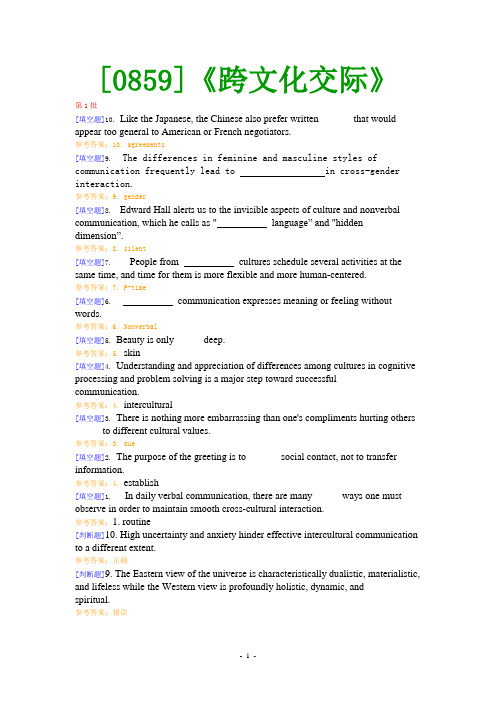
[0859]《跨文化交际》第1批[填空题]10. Like the Japanese, the Chinese also prefer written ______ that would appear too general to American or French negotiators.参考答案:10. agreements[填空题]9. The differences in feminine and masculine styles of communication frequently lead to in cross-gender interaction.参考答案:9. gender[填空题]8. Edward Hall alerts us to the invisible aspects of culture and nonverbal communication, which he calls as " language” and "hidden dimension”.参考答案:8. silent[填空题]7. People from cultures schedule several activities at the same time, and time for them is more flexible and more human-centered.参考答案:7. P-time[填空题]6. communication expresses meaning or feeling without words.参考答案:6. Nonverbal[填空题]5. Beauty is only _____ deep.参考答案:5. skin[填空题]4. Understanding and appreciation of differences among cultures in cognitive processing and problem solving is a major step toward successful ______ communication.参考答案:4. intercultural[填空题]3. There is nothing more embarrassing than one's compliments hurting others _____ to different cultural values.参考答案:3. due[填空题]2. The purpose of the greeting is to ______ social contact, not to transfer information.参考答案:4. establish[填空题]1. In daily verbal communication, there are many _____ ways one must observe in order to maintain smooth cross-cultural interaction.参考答案:1. routine[判断题]10. High uncertainty and anxiety hinder effective intercultural communication to a different extent.参考答案:正确[判断题]9. The Eastern view of the universe is characteristically dualistic, materialistic, and lifeless while the Western view is profoundly holistic, dynamic, and spiritual.参考答案:错误[判断题]8. Due to the cultural differences, interpreting in intercultural encounters is possible but difficult.参考答案:正确[判断题]7. Cultural differences can generate positive impacts on negotiation as people can learn from each other.参考答案:错误[判断题]6.A lady might be feminine, masculine or a combination of both.参考答案:正确[判断题]1) 5. Environment is one of the five study areas that nonverbal communication covers.参考答案:正确[判断题]4. "Dragon” means the same to the Westerners as "龙” to the Chinese.参考答案:错误[判断题]3. Sometimes the Chinese way of showing modesty must be considered as fishingfor compliments.参考答案:正确[判断题]2. All cultures require and value politeness, but the ways in which politenessis ` achieved may vary significantly.参考答案:正确[判断题]1. All people of the same nationality will have the same culture.参考答案:错误第2批[论述题]Define the following terms:1. Nonverbal communication2. Body language/Kinesics3. world view4. the Judeo-Christian tradition5. knowledge6. stereotype参考答案:1. Nonverbal communication is the process by which nonverbal behaviors are used, either singly or in combination with verbal behaviors, in the exchange and interpretation of messages within a given situation or context.2. Body language refers to the meaning representing devices as facial expressions and eye behaviors, gestures, and postures.3. A comprehensive world view (or worldview) is the fundamental cognitive orientation of an individual or society encompassing natural philosophy; fundamental existential and normative postulates; or themes, values, emotions, and ethics4. Judeo?Christian (sometimes written as Judaeo?Christian) refers to a set of beliefs and ethics held in common by Judaism and Christianity. It is a common term in American cultural and political rhetoric.5. Knowledge is defined by the Oxford English Dictionary as (i) expertise, and skills acquired by a person through experience or education; the theoretical or practical understanding of a subject; (ii) what is known in a particular field or in total; facts and information; or (iii) awareness or familiarity gained by experience of a fact or situation.6. A stereotype or "stereotypes" is a commonly held public belief about specific social groups or types of individuals. The concepts of "stereotype" and "prejudice" are often confused with many other different meanings. Stereotypes are standardized and simplified conceptions of groups based on some prior assumptions.第3批[论述题]Define the following terms.1. nonverbal communication2. culture shock3. gender4. stereotype5. body language参考答案:1.Nonverbal communication is the process by which nonverbal behaviors are used, either singly or in combination with verbal behaviors, in theexchange and interpretation of messages within a given situation or context.2.Culture shock is precipitated by the anxiety that results from losing all our familiar signs and symbols of social intercourse. The main cause of cultu re shock is displacement from our "home” culture. This lack of common experiences and familiar surroundings creates varying degrees of consequences.3.Gender and sex are not synonymous. Sex is determined by genetics and biology, while gender is produced and reproduced by society. Societies create meanings of gender; in turn, individuals become gendered as they embody social prescriptions in their personal identities.4.Stereotype is a complex form of categorization that mentally organizes our experiences and guides our behavior toward a particular group of people. There are a number of reasons that stereotypes, as a form of classification, hamper intercultural communication.5.Body language refers to the meaning representing devices as facial expressions and eye behaviors, gestures, and postures.[论述题]Analyze the following cases,and then answer the given questions.Case 1How would you explain the Director's behavior toward Katherine? How would you make the Director understand why Katherine felt frustrated and angry?Katherine came to Beijing in 1998 and found a job as an English teacher in a foreign language institute. Soon after her classes began, she found that her students showed no interest in her teaching style. Quite a few of them avoided attending her class. She was feeling quite upset and discouraged so she decided to ask the Director, Prof. Wang reviewed his timetable and suggested they meet at ten o` clock on Thursday morning. When Thursday came, Katherine arrived at Prof. Wang` office at the exactly ten o` clock finding him talking with another teacher in Chinese. Seeing that she had come, Prof. Wang smiled and gestured her to sit down. Katherine sat down and the professor excused himself and continued to talk with the other teacher. After five minutes, he finished hisconversation, and apologized to Katherine, and began to focus his attention on her situation. Prof. Wang showed great concern and asked her what the problem was. Just as she was discussing her problem, another Chinese teacher interrupted, with a form that required the Director` s signature. The Director smiled, apologized to Katherine again, and turned to talk with the Chinese teacher in Chinese. Katherine became impatient, and wondered why their discussion should be interrupted since she had made an appointment. Also, she was upset and frustrated that they continued to speak Chinese in front of her. Although their talk continued, she was apparently unhappy about what had happened.Case 2Why does Jay refuse to ask his professor or classmen to clarify the directions for his paper?Jay is having difficulty in writing a paper for his communication class, because he's not sure what the professor wants. When he mentions this to his friend Ellen, she suggests he ask the professor or a classmen to clarify directions. Jay refuses, saying "I can figure it out on my own”.参考答案:2. In this case, Jay's unwillingness to ask others for help in understanding his assignment is a sign of his masculine emphasis on independence. As some scholars point out rather humorously, men invariably resist asking directions when they are lost in the road while women do not hesitate to ask strangers for help. What we have discussed about gender identity help us understand this difference. Because women initially develop identity within the first relationships have an undertone of danger-they could jeopardize independence. So Jay's refusal to ask others for help reflects the masculine emphasis on maintaining autonomy and not appearing weak or incompetent. Unless Ellen realizes this difference between them, Jay's behavior will continue to baffle her.)[填空题]10.One of the most fundamental ways culture shapes our being is throughexplicit and implicit ________ about our relationship to the nature of the universe and to the non-human natural world.参考答案:10. teachings[填空题]9. Native speakers need to admit that difficulty in understanding _______ also occurs among native speakers and reminds non-native speakers to be open about explanations given.参考答案:9. humor[填空题]8. The American _______ is to conduct business in an efficient manner,while compromises may be part of the outcome.参考答案:8. n orm[填空题]7. The differences in feminine and masculine styles of communication frequently lead to ________in cross-gender interaction.参考答案:7. misunderstanding[填空题]6. communication expresses meaning or feeling without words.参考答案:6. Nonverbal[填空题]5.Understanding and appreciation of differences among cultures in cognitive processing and problem solving is a major step toward successful ______ communication.参考答案: 5. intercultural[填空题]pliments and compliment responses are an _______ part of daily verbal communication.参考答案:4. essential[填空题]3. Being unaware of the difference, intercultural communication ______ occurs here and there.参考答案:3. breakdown[填空题]2. When communicating with each other, each person ___________ and sends messages, and in turn receives and decodes messages.参考答案:2. encodes[填空题]1.Intercultural competence requires sufficient knowledge, suitable _______, and skilled actions.参考答案:1. motivations[单选题]10. The Chinese phrase "知识分子” has the same meaning as "intellectual”.A:TB:F参考答案:B[单选题]9.Although cultural stereotype has its limitations(over-generalization), it still contributes to a person's cultural cognition.A:TB:F参考答案:A[单选题]8.It is very important for nonnative speakers to learn to communicate incomprehension through idiomatic expressions as well as nonverbal gestures.A:TB:F参考答案:A[单选题]7.We should avoid unconsciously adopting our cultural rules and norms in communication in the American or British context.A:TB:F参考答案:A[单选题]6.In Asian cultures, signed agreements are far less important than keeping the interdependent, interwoven organizations involved in a good relationship.A:TB:F参考答案:A[单选题]5. The first and last principle for effective cross-gender communication is suspending judgment.A:TB:F参考答案:A[单选题]4. The social functions of Chinese and English compliments are roughly the same.A:TB:F参考答案:A[单选题]3. There are as many similarities as dissimilarities between English proverbs and Chinese proverbs.A:TB:F参考答案:B[单选题]2. The Chinese way of showing concern is usually appreciated by the Westerners.A:TB:F参考答案:B[单选题]1. Culture is a static entity while communication is a dynamic process.A:TB:F参考答案:B第4批[判断题]8.It is very important for nonnative speakers to learn to communicate incomprehension through idiomatic expressions as well as nonverbal gestures.参考答案:正确[判断题]7.We should avoid unconsciously adopting our cultural rules and norms in communication in the American or British context.参考答案:正确[判断题]5. The first and last principle for effective cross-gender communication is suspending judgment.参考答案:正确[判断题]4. The social functions of Chinese and English compliments are roughly the same.参考答案:正确[判断题]2. The Chinese way of showing concern is usually appreciated by the Westerners.参考答案:错误[判断题]1. Culture is a static entity while communication is a dynamic process.参考答案:错误[判断题]9.Although cultural stereotype has its limitations(over-generalization), it still contributes to a person's cultural cognition.参考答案:正确[论述题]Analyze the following casesCase 1Why did the two Korean interpreters continue to study the Chinese female teachers` trousers?In 1987, a delegation consisting of four Chinese English experts went to Pingyong Foreign Language University to train faculty to be top-level simultaneous interpreters for the 13th International Youth Festival. Of the four experts, two were men and two were women. The two men were dressed in suits with ties and the two women were typically dressed in trousers and their typical business clothes. An authority from Pingyong Foreign Language University and two Korean interpreters greeted them at the Pingyong Railway Station. Surprisingly, while exchanging a few formal remarks, the two interpreters` eyes consistently observed the two Chinese female teachers' trousers. The younger teacher, sensed something and repeatedly checked their trousers and shoes to see if they were dirty or marked. About half an hour later, they arrived at the hotel where they would be staying during their mission. The two interpreters showed eachof them to their rooms to give them an opportunity to freshen up before the formal introductions. In a couple of minutes, the four Chinese teachers gathered in one of the rooms, where the head of the university and the two interpreters introduced themselves further and briefed them on the training program. While talking, the two interpreters seemed to continue to study the two female teachers` trousers. At first, they thought that the Korean interpreters were too embarrassed to look straight in the eyes of a woman. Later this assumption was proved wrong. The four Chinese teachers remained a bit puzzled and did not know what was going on…Case 2Could you explain to Dick why Chen Liang walked into the cafeteria without waiting for him?After graduating from Beijing International Studies University, Chen Liang pursued an MA program at a university in Boston, the U.S. Early in the program, he made friends with some of the American friends, Dick, asked Chen to join him in the university cafeteria. On their way they ran into Dick's girlfriend, Lisa, who was on her way to a lecture. Walking shoulder to shoulder, Dick and Lisa carried on an intimate conversation, as if they hadn't seen each other for ages. Meanwhile, Chen Liang was walking behind them, not taking part in the conversation. When they were nearing the cafeteria Lisa said she had to leave for the lecture. Dick turned away and walked off toward the cafeteria. When Dick looked up, he saw Chen waking into the cafeteria. Dick was puzzled as to why Chen didn't wait for him, and went to the cafeteria alone.参考答案:1. Comment: this is a typical cultural clash between Chinese and Westerners. There is a great difference in the concept of appointment and its behavior pattern in different cultures. To Americans, an appointment is a confirmation to meet at a precise time. If an appointment is scheduled, both parties should respect the appointment time, it should not be interrupted by other things or people. In addition, Westerners are goodtimekeepers; they adhere strictly to schedules. However, Chinese view appointment in a more flexible manner. They are more causal about commitments. This difference in attitudes toward appointment was the roof of Katherine` s unhappiness. Since the Director made a ten o` clock appointment, he should have tried to avoid any interruption. However, when Katherine arrived on time, the Director was still talking with another teacher. When their meeting finally began, it was interrupted again. There is no wonder Katherine became frustrated and angry.2. Suggested answer:In public, the norms of expressing one's feeling and affections toward the opposite sex vary across culture. In Asia and some countries around the Mediterranean Sea, it is acceptable to have body contact between the same sexes in public, but not between the opposite sexes, especially in front of the friends. Chen left because he felt awkward witnessing them hugging and kissing. This shows that Dick knows nothing about the natural response of the Chinese to certain behaviors. Similarly, Chen Liang's behavior shows that he is also in the dark about American behaviors.[填空题]9. In broad terms, nonverbal communication covers four areas: timelanguage (temporal language or chronemics), space language (spatial language or proxemics), language(body movement orkinesics), and paralanguage (voice modulation).参考答案:9. body[论述题]Define the following terms.1. nonverbal communication2. economic globalization3. gender4. linear time5. intercultural communication competence参考答案:1.Nonverbal communication is the process by which nonverbal behaviors are used, either singly or in combination with verbal behaviors, in the exchange and interpretation of messages within a given situation or context.2.No country is the dominant economic force in the world. Economic expansion in globalization has resulted in multinational corporations participating in joint ventures, licensing agreements and other international business arrangements.3.Gender and sex are not synonymous. Sex is determined by genetics and biology, while gender is produced and reproduced by society. Societies create meanings of gender; in turn, individuals become gendered as they embody social prescriptions in their personal identities.4.The West views time either as an arrow or as a moving river that comes from a distant place in the past and goes to an equally distant place in the future. In this linear view of time, history is goal-directed and gradually progressing in a certain direction.5.Intercultural communication competence (ICC competence) is the ability to effectively and appropriately execute communication behaviors to elicit a desired response in a specific environment.[判断题]10. The Chinese phrase "知识分子” has the same meaning as "intellectual”.参考答案:错误[判断题]6.In Asian cultures, signed agreements are far less important than keeping the interdependent, interwoven organizations involved in a good relationship.参考答案:正确[判断题]3. There are as many similarities as dissimilarities between English proverbs and Chinese proverbs.参考答案:错误[填空题]10.According to researchers, there are two primary influences ongender : family communication, particularly betweenmothers and children, and recreational interaction among children.参考答案:10. socialization[填空题]8. Like the Japanese, the Chinese also prefer written ______ that would appear too general to American or French negotiators.参考答案:8. agreements[填空题]7. To develop ________means being able to see things from the point ofview of others so that we can better know and adjust to the other people.参考答案:7. empathy[填空题]6. We need to understand what is ordinarily done in a _______ in order to understand and laugh at messages that are the " out of the ordinary”.参考答案:6. culture[填空题]5.A term in one language does not necessarily have a ______ in the other language.参考答案:5. counterpart[填空题]4.There is nothing more embarrassing than one's compliments hurtingothers _____ to different cultural values.参考答案:4. due[填空题]3.Understanding and appreciation of differences among cultures in cognitive processing and problem solving is a major step toward successful ______ communication.参考答案:3. intercultural[填空题]2.Being unaware of the difference, intercultural communication ______ occurs here and there.参考答案:2. breakdown[填空题]1.Intercultural communication occurs whenever there is communication between people from different cultural ______________.参考答案:1. backgrounds。
你是否曲解他人情感英语
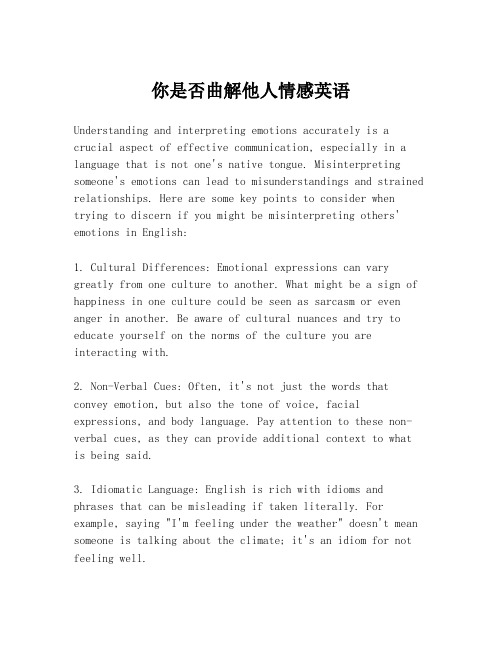
你是否曲解他人情感英语Understanding and interpreting emotions accurately is a crucial aspect of effective communication, especially in a language that is not one's native tongue. Misinterpreting someone's emotions can lead to misunderstandings and strained relationships. Here are some key points to consider when trying to discern if you might be misinterpreting others' emotions in English:1. Cultural Differences: Emotional expressions can vary greatly from one culture to another. What might be a sign of happiness in one culture could be seen as sarcasm or even anger in another. Be aware of cultural nuances and try to educate yourself on the norms of the culture you are interacting with.2. Non-Verbal Cues: Often, it's not just the words that convey emotion, but also the tone of voice, facial expressions, and body language. Pay attention to these non-verbal cues, as they can provide additional context to what is being said.3. Idiomatic Language: English is rich with idioms and phrases that can be misleading if taken literally. For example, saying "I'm feeling under the weather" doesn't mean someone is talking about the climate; it's an idiom for not feeling well.4. Sarcasm and Humor: Sarcasm can be particularly tricky to detect, especially for non-native speakers. It often involves a tone of voice or a certain type of delivery that can be hard to pick up on without a deep understanding of the language and its nuances.5. Directness vs. Indirectness: Some cultures are more direct in their communication styles, while others prefer a more indirect approach. Misinterpreting this can lead to confusion about the true emotional intent behind a message.6. Language Proficiency: The level of language proficiency plays a significant role in understanding emotions. As you become more fluent, you'll naturally become better at picking up on emotional cues.7. Context: Always consider the context in which a statement is made. The same phrase can have different emotional implications depending on the situation.8. Ask for Clarification: If you're unsure about the emotional content of a message, it's perfectly acceptable to ask for clarification. This can help prevent misunderstandings and show that you are engaged andinterested in the conversation.9. Empathy: Try to put yourself in the other person's shoes. Empathy can help you understand their feelings and respond appropriately.10. Feedback: Seek feedback from others on your understandingof their emotions. This can be a valuable learning tool to improve your emotional intelligence in English.By being mindful of these aspects, you can reduce the chances of misinterpreting emotions and improve your overall communication skills in English.。
跨文化交际论文参考题目

跨文化交际论文参考题目中西方文化差异的论文题目:中西方时间观念的比较中西方饮食文化的比较中西方教育的比较中西方问候语的比较中西方餐桌礼仪的差异中西方宗教文化对比中西方儿童文学的差异从文字比较看中西方文化差异礼貌中的中西方“面子文化”差异论中西方激励机制的差异比较和在医疗管理中的应用英语教学中的文化教学——中西方文化差异对比分析中西方价值观差异对交际模式的影响从历史中透视中西方经济差异形成的原因浅谈跨越中西方文化障碍日常生活中的中西方文化差异浅析中西方隐私观的差异中西方古代体育和谐思想比较研究中西方传统犯罪控制思想之比较土地与海洋的对话——中西方文化与人格差异之浅见汉英商标翻译与中西方文化差异中西方孝文化探析从文化视角看中西方教育思想的差异中西方语言与文化的差异中西方哲学语言观的差异浅析中西方文化差异对翻译的影响从素质教育看中西方教育的差异及思考中西方立宪文化差异比较——以价值观为视角影响跨文化交际的主要因素——中西方价值观念差异中西方股票期权制度实际操作的差异性分析英美社会与文化论文1. The Contrast and Analyses of Customsin Britain and China英国和中国习俗之研究2. Cultural Connotation of English Names 英语姓名的文化内涵3. Black Culture and American English 黑人文化与美国英语4. The Phenomenon of “PoliticalCorrectness” in American English论美国英语中的政治正确现象5. English Euphemism and Culture 文化因素与委婉语6. Cultural Differences in Address Terms: English and Chinese英汉称呼语中的文化差异7(Influence of Greek Myths to British and American Culture希腊神话与英美文化8. An Investigation on Intercultural Communication Competence and Intercultural Sensitivity Among Chinese College Students 关于中国大学生跨文化交际能力和跨文化敏感度的调查9. Cross-Cultural Awareness in Translating Tourist Materials中国旅游资料翻译中的跨文化意识10. Cross-Cultural Training in Chinese Universities中国大学中的跨文化培训11. Acculturation Strategies among Chinese Overseas Students中国海外留学生的文化适应策略12. On Tour Commentary Translation---An Intercultural Communication Perspective 从跨文化角度看导游词翻译13. Intercultural Communication on the Internet互联网上的跨文化交际14. On the Application of Theatrical Tricks tothe Shake speare’s Dramas论莎士比亚戏剧中的舞台技巧的应用15. The Bible and Western Festivals 《圣经》与西方节日16. On Culture-loaded Animal Words in Cross-Cultural Communication跨文化交际中的动物文化词研究17. The Cultural Differences Between Chinese and English from the Cultural Attached Meaning of Animal Words 从动物词汇看汉英文化的差异18. On Plants Words and Culture 论植物词汇与文化19. On the Cultural Connotations of Color Words in English and Chinese中英颜色词文化内涵研究20. Cross-cultural Communication on the Translation of the Chinese “Long”从中国“龙”字的翻译看跨文化交际21. On English and the Chinese Borrowing Words and the Cultural Differences 论中英借用词与文化差异22. A Contrast of the Symbols of American and Chinese Culture中美文化象征比较研究23. The Contrastive Study on the Courteous Expressions in English and Chinese 英汉礼貌用语对比研究24. Body Language in Non-verbal Communication浅谈非语言交际中的身势语25. Culture Consciousness in the English Language Teaching英语教学中的文化意识26. Reinforcing Equality in Cultural Communication in Cross-cultural Communication跨文化交际应加强文化平等交流意识27. Cross-cultural Difference on the Non-verbal Communication非言语交际的跨文化差异28. Improper Cultural Transferences in Cross-Cultural Communication文化负迁移对跨文化交际的影响29. On Cross-Cultural Communication Phenomenon论跨文化交际现象30. The Difference of Cultural Thinking Between English and Chinese and the Intercultural Communication英汉文化思维差异与跨文化交流31. Chief Factors Affecting Cross-Cultural Communication--- Difference Between Chinese and Western Values影响跨文化交际的主要因素---中西方价值观念差异32. Taboos in Cross-CulturalCommunication--- Probing into the Difference Between Western and Chinese Culture 跨文化交际中的禁忌问题---中西方文化差异之探讨33. Cultural Differences in Cross-Cultural Communication Between Chinese and English Language谈英汉跨文化交际中的文化差异34. The Difference of the Eastern and Western Mode of Thinking and Cross-Cultural Communication中西思维模式差异与跨文化差异35. Cross-Cultural Communication in Interpretation口译中的跨文化交流36. The Cultural Perception and Memory in Intercultural Communication跨文化交流中的文化感知和文化记忆37(Cultural Factors of English Catchwords英语流行语的文化因素38(The Epitome of Contemporary American History and Culture--- Interpreting Forrest Gump当代美国历史和文化的缩影---解读《阿甘正传》39. Body Language in Non-verbalCommunication浅谈非语言交际中的身势语40. Differences and Resources of Addressing in English英汉语中称谓的差异及其成因41. Cultural Interpretations of English and Chinese Names英汉姓名的文化阐释42. Different Body Languages in Different Cultures身势语在不同文化下的差异43. Functions of Non-verbal Behavior in Intercultural Communication非言语行为在跨文化交际中的功能44. The Contrastive Study on the Courteous Expressions in English and Chinese 英汉礼貌用语对比研究45. The Presentation of Different Thinking Modes in Chinese and Western Religious Cultures中西方宗教文化中的不同思维模式46. The Breath of American Slang美国俚语初探47. The Influences of Western Festivals on Chinese Society西方节日对中国社会的影响48. Cultural Migration of Western Festivals 西方节日的文化入侵49. The Influence of Borrowing Words on English and Chinese Vocabulary英汉词语互借对语言文化的影响50(Cross-Cultural Communication in Business World商务领域跨文化现象51(Christianity and American Culture 基督教与美国文化52. The Studies of Chinese Movies and Culture中国电影与文化53. Cultural Implication of Chinese Cuisine 中国饮食文化的内涵54. Diversities of Chinese and Western Culture from the Sources of English and Chinese Idioms从汉英习语来源看中西方文化的差异55. The Social Status of the Blacks in America after the Civil War美国内战后的黑人社会地位56. A Comparison of Garments Culture between the East and the West中西服饰文化对比57. A Research on Cross-Cultural Difficulties in Reading Comprehension影响阅读理解的跨文化因素研究58. The Reasons of Ancient Greek Mythology Influencing the English Language古希腊神话故事对英语语言影响的原因59. A Cultural Perspective on Chinese and Western Trademarks中西方商标的文化视角60(English Idioms and the Western Culture 英语习语和西方文化61. A Tentative Study on English and Chinese Euphemism汉英委婉语研究62(American Place Names and Their Culture 美国地名和文化63(A Comparison of Courtesy Conventions between Chinese and English 汉英礼貌用语的异同64(Animal Words in Chinese and English Idioms and Their Translations 中英习语动物词异同及其翻译65. Cultural Differences on Etiquette betweenChina and Western Countries中西方礼仪文化差异66(Increasing Cultural Awareness of Secondary School Students如何提升中学生的文化意识67(A Comparative Study of Compliments: Cross-Culture Perspectives 从跨文化的角度对比中西方问候语的差异下面的是2016年经典励志语录,需要的朋友可以欣赏,不需要的朋友下载后可以编辑删除~~谢谢~~1、有来路,没退路;留退路,是绝路。
安全规定怎么用英文(3篇)
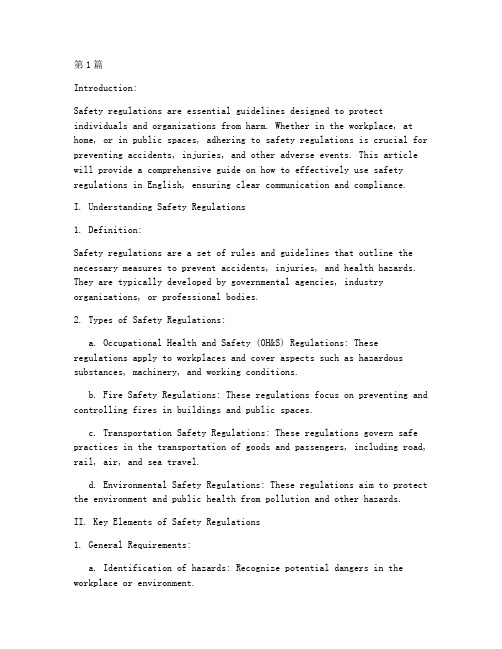
第1篇Introduction:Safety regulations are essential guidelines designed to protect individuals and organizations from harm. Whether in the workplace, at home, or in public spaces, adhering to safety regulations is crucial for preventing accidents, injuries, and other adverse events. This article will provide a comprehensive guide on how to effectively use safety regulations in English, ensuring clear communication and compliance.I. Understanding Safety Regulations1. Definition:Safety regulations are a set of rules and guidelines that outline the necessary measures to prevent accidents, injuries, and health hazards. They are typically developed by governmental agencies, industry organizations, or professional bodies.2. Types of Safety Regulations:a. Occupational Health and Safety (OH&S) Regulations: These regulations apply to workplaces and cover aspects such as hazardous substances, machinery, and working conditions.b. Fire Safety Regulations: These regulations focus on preventing and controlling fires in buildings and public spaces.c. Transportation Safety Regulations: These regulations govern safe practices in the transportation of goods and passengers, including road, rail, air, and sea travel.d. Environmental Safety Regulations: These regulations aim to protect the environment and public health from pollution and other hazards.II. Key Elements of Safety Regulations1. General Requirements:a. Identification of hazards: Recognize potential dangers in the workplace or environment.b. Risk assessment: Evaluate the likelihood and severity of harm caused by identified hazards.c. Control measures: Implement measures to eliminate or reduce risks to an acceptable level.d. Training and education: Ensure that individuals are trained and educated on safety practices.2. Specific Requirements:a. Personal Protective Equipment (PPE): Provide appropriate PPE to workers, such as gloves, helmets, and goggles.b. Machinery and Equipment: Ensure that machinery and equipment are properly maintained, inspected, and used safely.c. Emergency Procedures: Establish emergency response plans and provide training on their use.d. Reporting and Record-Keeping: Maintain records of accidents, injuries, and near-misses, and report them to the relevant authorities.III. Communicating Safety Regulations in English1. Use Clear and Concise Language:a. Avoid complex jargon and technical terms.b. Use simple, straightforward sentences to convey information effectively.2. Proper Grammar and Syntax:a. Use correct grammar and punctuation to ensure clarity.b. Pay attention to sentence structure and avoid run-on sentences.3. Active Voice:a. Use the active voice to make statements more direct and engaging.b. For example, "Employees must wear helmets at all times" instead of "Helmets must be worn by employees at all times."4. Use of Headings and Subheadings:a. Organize information into sections with clear headings and subheadings.b. This helps readers quickly locate relevant information.5. Visual Aids:a. Include diagrams, charts, and illustrations to support written instructions.b. Visual aids can enhance understanding and compliance with safety regulations.6. Cultural Considerations:a. Be mindful of cultural differences in understanding and interpreting safety regulations.b. Adapt language and examples to ensure clarity for diverse audiences.IV. Implementing Safety Regulations1. Training and Education:a. Conduct regular training sessions to ensure that individuals are aware of safety regulations.b. Use various training methods, such as workshops, presentations, and hands-on demonstrations.2. Communication and Awareness:a. Display safety signs, posters, and banners in visible areas.b. Use emails, newsletters, and intranet to communicate safety information.3. Monitoring and Enforcement:a. Regularly inspect workplaces and public spaces to ensure compliance with safety regulations.b. Enforce consequences for non-compliance, such as fines, disciplinary actions, or temporary closures.4. Continuous Improvement:a. Review and update safety regulations regularly to address new hazards and challenges.b. Encourage feedback from employees and stakeholders to improve safety practices.Conclusion:Using safety regulations effectively in English is crucial for ensuring a safe and healthy environment. By understanding the key elements of safety regulations, communicating them clearly, and implementing them consistently, organizations can reduce accidents, injuries, and health hazards. Adhering to safety regulations not only protects individuals but also contributes to a more productive and sustainable future.第2篇Safety regulations are crucial in any workplace, ensuring that employees are protected from hazards and risks. Properly using safety regulations in English is essential for effective communication and compliance. This article will provide a comprehensive guide on how to use safety regulations in English, covering various aspects such as understanding the regulations, communicating them effectively, and implementing themin the workplace.I. Understanding Safety RegulationsBefore using safety regulations in English, it is essential to have a thorough understanding of the regulations themselves. This includes:1. Types of Safety Regulations: Familiarize yourself with the different types of safety regulations, such as general safety regulations, occupational health and safety regulations, and specific equipment or substance regulations.2. Legal Framework: Understand the legal framework that governs safety regulations in your country or region, including relevant laws, standards, and codes of practice.3. Regulatory Bodies: Identify the regulatory bodies responsible for enforcing safety regulations and reporting violations.4. Risk Assessment: Learn how to conduct risk assessments to identify potential hazards and determine the appropriate safety measures.II. Communicating Safety Regulations in EnglishEffective communication of safety regulations is key to ensuring compliance and preventing accidents. Here are some tips for communicating safety regulations in English:1. Use Clear and Concise Language: Avoid complex or technical jargon that may confuse employees. Use simple, straightforward language to convey the message.2. Translation and Localization: If you are working in a multicultural environment, ensure that safety regulations are translated into the languages spoken by your employees. Localize the regulations to reflect cultural differences and ensure they are understood.3. Visual Aids: Utilize visual aids such as posters, signs, and videos to reinforce safety messages. Ensure that these materials are clear, easily understandable, and displayed in visible locations.4. Training Programs: Develop training programs that cover the safety regulations in detail. Use interactive methods, such as workshops, simulations, and role-playing, to enhance understanding and retention.5. Regular Communication: Keep safety regulations at the forefront of communication by regularly reminding employees of the rules and emphasizing their importance.III. Implementing Safety Regulations in the WorkplaceImplementing safety regulations in the workplace involves more than just communicating the rules. Here are some steps to ensure effective implementation:1. Policy Development: Develop comprehensive safety policies that align with relevant regulations. Ensure that these policies are accessible to all employees and regularly reviewed and updated as needed.2. Assign Responsibilities: Clearly define the roles andresponsibilities of each employee regarding safety. This includes supervisors, who are responsible for ensuring compliance and addressing any safety concerns.3. Safety Inspections: Conduct regular safety inspections to identify potential hazards and ensure that safety measures are in place. Document findings and take corrective actions as necessary.4. Incident Reporting: Establish a system for reporting accidents, injuries, and near-misses. Investigate incidents promptly and take appropriate actions to prevent recurrence.5. Emergency Preparedness: Develop and practice emergency response plans to handle workplace incidents, such as fires, chemical spills, ormedical emergencies.IV. Examples of Safety Regulations in EnglishHere are some examples of safety regulations in English that you might encounter in various industries:1. General Safety Regulations:- "Employees must wear appropriate personal protective equipment (PPE) when working with hazardous materials."- "All machinery must be equipped with safety guards to prevent accidents."2. Occupational Health and Safety Regulations:- "Employees must undergo regular health screenings to monitor exposure to harmful substances."- "Workplaces must be maintained in a clean and orderly condition to prevent accidents and maintain employee health."3. Equipment and Substance Regulations:- "Electrical equipment must be regularly inspected and maintained to prevent electrical hazards."- "Chemical substances must be stored in designated areas and handled according to specific procedures."V. ConclusionUsing safety regulations in English is a critical aspect of ensuring a safe and healthy workplace. By understanding the regulations, communicating them effectively, and implementing them in the workplace, you can create a safer environment for your employees and reduce therisk of accidents and injuries. Always remember that safety is a shared responsibility, and everyone plays a role in maintaining a safe workplace.第3篇第一部分:安全规定概述1. 定义安全规定是指为保障员工、公众和财产的安全而制定的一系列规章制度。
how are you教学反思
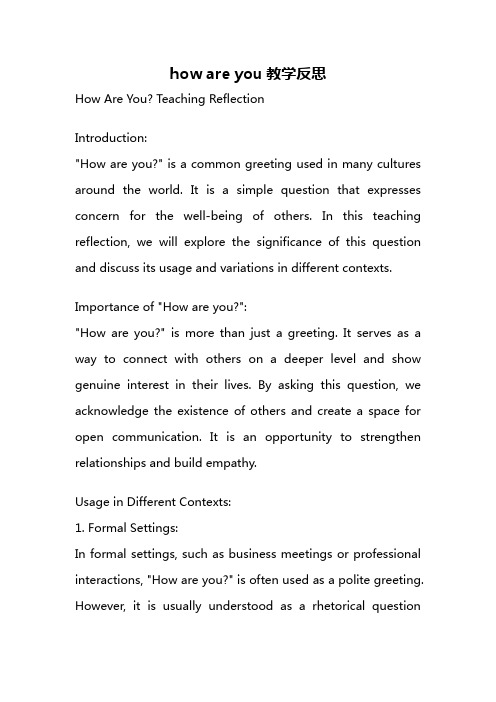
how are you教学反思How Are You? Teaching ReflectionIntroduction:"How are you?" is a common greeting used in many cultures around the world. It is a simple question that expresses concern for the well-being of others. In this teaching reflection, we will explore the significance of this question and discuss its usage and variations in different contexts.Importance of "How are you?":"How are you?" is more than just a greeting. It serves as a way to connect with others on a deeper level and show genuine interest in their lives. By asking this question, we acknowledge the existence of others and create a space for open communication. It is an opportunity to strengthen relationships and build empathy.Usage in Different Contexts:1. Formal Settings:In formal settings, such as business meetings or professional interactions, "How are you?" is often used as a polite greeting. However, it is usually understood as a rhetorical questionrather than an invitation to share personal details. A simple response like "I'm fine, thank you" is sufficient in these situations.2. Casual Conversations:In casual conversations with friends, family, or acquaintances, "How are you?" is more likely to be a genuine inquiry about one's well-being. It invites a more detailed response and encourages individuals to share their feelings, experiences, and challenges. In these contexts, it is essential to actively listen and provide support if needed.3. Cultural Differences:It is important to note that the interpretation of "How are you?" may vary across cultures. In some cultures, people tend to be more reserved and may not feel comfortable discussing personal matters with others. In contrast, other cultures value open and honest communication, and individuals may share more intimate details when asked this question. Understanding cultural differences can help avoid misunderstandings and promote effective communication.Variations of "How are you?":1. "How's it going?":This variation is commonly used in informal settings and is an alternative way to ask about someone's well-being. It is less formal than "How are you?" and often elicits a similar response.2. "How have you been?":This variation implies a longer time span and is often used when reconnecting with someone after a period of separation. It encourages individuals to share updates on their lives and fosters deeper conversations.3. "How are you doing?":Similar to "How are you?", this variation invites individuals to express their feelings and emotions. It acknowledges that one's well-being is not solely determined by external factors but also by internal states.Teaching Reflection:Teaching the proper usage of "How are you?" involves more than just explaining its meaning and variations. It requires emphasizing the importance of active listening and empathy. Encourage students to genuinely inquire about others' well-being and actively engage in conversations. Additionally, discussing cultural differences in interpreting this question can help students develop cross-cultural communication skills.Conclusion:"How are you?" is a simple yet powerful question that reflects our concern for others' well-being. Its usage varies depending on the context, and understanding these variations is crucial for effective communication. As educators, we can teach our students the importance of this question and help them develop empathy and active listening skills. By doing so, we can foster stronger relationships and create a more compassionate society.。
各个国家的肢体语言英语作文

各个国家的肢体语言英语作文Body language is a universal form of nonverbal communication that transcends spoken language and cultural boundaries. It encompasses a wide range of physical expressions, gestures, and movements that convey meaning and emotion. The way individuals use their bodies to communicate can vary significantly across different countries and cultures, reflecting the unique social norms, values, and traditions of each region. Understanding the nuances of body language in various cultural contexts is crucial for effective cross-cultural communication and interaction.One of the most prominent examples of cultural differences in body language is the concept of personal space. In Western cultures, such as in the United States and Western Europe, individuals generally maintain a larger personal space bubble, often keeping a comfortable distance from others during conversations. However, in many Asian and Latin American countries, a closer physical proximity is considered more natural and acceptable. In these cultures, standing or sitting closer to others, making more frequent physical contact, and engaging in more frequent eye contact are often seenas signs of friendliness and openness.Another significant cultural difference in body language is the use of hand gestures. In Italy, for instance, hand gestures are an integral part of everyday communication, with Italians frequently using their hands to emphasize their speech and convey additional meaning. The "OK" gesture, which is commonly used in the United States to indicate approval, can have a very different meaning in some cultures. In Brazil, for example, this gesture is considered offensive and rude. Similarly, the thumbs-up sign, which is a positive gesture in Western countries, is seen as an insult in parts of the Middle East and Asia.Facial expressions also vary in their interpretation across cultures. In some Asian cultures, maintaining a neutral or poker-face expression is considered a sign of respect and self-control, while in Western societies, a more expressive and animated facial display is often expected and valued. The act of smiling, which is generally seen as a positive and friendly gesture in the West, can be interpreted differently in other parts of the world. In Japan, for instance, a smile may be used to mask negative emotions or to convey politeness, rather than a genuine expression of happiness.The way individuals use their eyes to communicate can also be influenced by cultural norms. In many Western cultures, making direct eye contact is seen as a sign of confidence, honesty, andengagement. However, in some Asian and African cultures, prolonged eye contact can be perceived as a challenge or a sign of disrespect, particularly when interacting with elders or those in positions of authority.Cultural differences in body language can also extend to the way individuals use their bodies to express emotions. In some Latin American countries, for example, passionate and expressive physical gestures, such as hugging, kissing, and hand-holding, are more commonly accepted and even expected in social interactions. In contrast, in more reserved cultures, such as in Scandinavia, physical displays of affection may be considered inappropriate or even uncomfortable.Understanding and navigating these cultural differences in body language is crucial for effective cross-cultural communication and interaction. Misinterpreting or misunderstanding the nonverbal cues of others can lead to confusion, misunderstandings, and even offense. By being aware of and sensitive to the diverse ways in which people use their bodies to communicate, individuals can improve their ability to interact with people from different cultural backgrounds, build stronger relationships, and avoid potential cultural faux pas.In conclusion, body language is a complex and multifaceted aspectof human communication that varies significantly across different cultures. From personal space to hand gestures, facial expressions, and the use of the eyes, the way individuals use their bodies to convey meaning and emotion is deeply rooted in the cultural norms and traditions of their respective societies. By developing a deeper understanding and appreciation of these cultural differences in body language, individuals can enhance their cross-cultural communication skills, foster greater cultural understanding, and navigate the nuances of global interactions with greater ease and effectiveness.。
介绍指路英语作文

介绍指路英语作文Title: Guiding Directions: Navigating Through English Composition。
Introduction:Navigating through the intricacies of giving directions in English requires clarity, precision, and effective communication skills. Whether it's guiding a lost touristin a bustling city or explaining directions to a friend, mastering the art of providing guidance in English is a valuable skill. In this composition, we delve into the nuances of giving directions in English, exploring various scenarios and strategies to ensure effective communication.Understanding the Basics:Before delving into the specifics, it's crucial to grasp the fundamental elements of giving directions in English. Clarity and simplicity are key. Start byidentifying key landmarks or reference points that can serve as anchors for the person receiving directions. Utilize cardinal directions (north, south, east, west) to provide orientation, and use descriptive language to enhance understanding.Example 1: Giving Directions in a City:Imagine you're approached by a lost tourist in the heart of a bustling city. How would you guide them to their destination? Begin by asking where they want to go and assess their starting point. Then, provide clear step-by-step instructions, incorporating prominent landmarks,street names, and distances.For instance:Start by orienting them: "You're currently facing north."Identify landmarks: "Do you see the large clock tower to your right?"Provide specific directions: "Walk two blocks eastuntil you reach Main Street."Offer reassurance: "You're on the right track. Keep going straight ahead."Recap the instructions: "Once you reach Main Street, turn left, and the museum will be on your right."Example 2: Explaining Directions to a Friend:In everyday situations, you might find yourself explaining directions to a friend over the phone. In such cases, clarity and patience are paramount. Visualize the route in your mind and convey it using clear, concise language.For instance:Start with a reference point: "You know the coffee shop on Maple Avenue?"Provide sequential instructions: "From there, head south for two blocks until you reach the park."Highlight landmarks along the way: "You'll pass by the bookstore and the flower shop."Offer additional guidance if needed: "If you reach the gas station, you've gone too far."Confirm understanding: "Got it? Great! See you soon."Advanced Strategies for Effective Communication:As you become more proficient in giving directions in English, consider incorporating advanced strategies to enhance clarity and precision.1. Visual Aids: Use maps, diagrams, or hand-drawn sketches to supplement verbal directions, especially in complex scenarios.2. Interactive Dialogue: Encourage the person receiving directions to ask questions or seek clarification to ensure mutual understanding.3. Cultural Sensitivity: Be mindful of cultural differences in interpreting directions, such as preferences for landmarks or spatial orientation.4. Adaptability: Tailor your approach based on the individual's language proficiency, familiarity with the area, and specific needs.Conclusion:Mastering the art of giving directions in English is a valuable skill that enhances communication and fosters understanding across diverse contexts. By employing clear language, utilizing landmarks, and adapting to individual needs, you can confidently guide others through unfamiliar territory. Whether it's navigating the streets of a city or simply helping a friend find their way, effectivedirection-giving is an essential aspect of communication in English.。
人教高中英语必修一各单元知识点汇总

人教高中英语必修一各单元知识点汇总Unit 1 Friendship1. Vocabulary: adjectives to describe people's characteristics (e.g. reliable, outgoing, generous, etc.)3. Reading: Understanding the main ideas and details in a reading passage, inferring the meaning of words from context4. Writing: Writing a letter of introduction, using appropriate greetings and closing statements5. Speaking: Discussing qualities of a good friend, expressing agreement or disagreement, expressing preferences Unit 2 English around the world1. Vocabulary: words related to language learning (e.g. fluent, bilingual, etc.), words related to education (e.g. curriculum, instruction, etc.)2. Grammar: Using "used to" to talk about past habits or states, using "would" to talk about past habits, using "will" and "would" to talk about future actions or intentions3. Reading: Understanding different types of texts (e.g. advertisements, news articles, etc.), inferring the purpose or tone of a text4. Writing: Writing an article about language learning, using appropriate structure and language5. Speaking: Discussing the importance of learning English, expressing opinions, giving reasons and examplesUnit 3 Travel journal1. Vocabulary: words related to travel and tourism (e.g. destination, ecotourism, etc.)2. Grammar: Using the present perfect tense to talk about experiences, using the present perfect continuous tense to talk about activities that started in the past and continue in the present3. Reading: Understanding a travel journal entry,identifying the main idea and supporting details4. Writing: Writing a travel journal entry, using appropriate descriptive language and organizing ideas chronologically5. Speaking: Discussing travel experiences, describing places visited, expressing preferences and opinionsUnit 4 Body language2. Grammar: Using the present continuous tense to talk about temporary actions or states, using the present simple tense to talk about general truths or habits3. Reading: Understanding an article about body language, understanding the purpose or main idea of a text4. Writing: Writing a dialogue about a misunderstanding due to body language, using appropriate dialogue format5. Speaking: Discussing cultural differences in body language, interpreting gestures and facial expressions, role-playing scenarios involving body language misunderstandings Unit 5 Nelson Mandela1. Vocabulary: words related to politics and human rights(e.g. apartheid, injustice, etc.)3. Reading: Understanding a biography of Nelson Mandela, identifying key events and milestones in his life4. Writing: Writing a biographical sketch about a famous person, using appropriate structure and language5. Speaking: Discussing the impact of Nelson Mandela's actions, expressing opinions on social justice issues, making connections between historical events and current events Unit 6 Inventors and inventions1. Vocabulary: words related to inventors and inventions(e.g. innovation, patent, etc.)2. Grammar: Using the present perfect tense to talk about achievements and discoveries, using the present perfect continuous tense to talk about actions or states that started in the past and continue in the present3. Reading: Understanding a passage about inventors and inventions, identifying the main idea and supporting details4. Writing: Writing a paragraph about a famous invention, using appropriate descriptive language and providing historical context5. Speaking: Discussing the significance of inventions, debating the ethics of scientific discoveries, predicting future inventionsUnit 7 Teenagers should be allowed to choose their ownclothes1. Vocabulary: words related to clothing and fashion (e.g. dress code, trend, etc.)2. Grammar: Using modal verbs to express possibility, permission, prohibition, etc., using conditional sentences to express hypothetical situations3. Reading: Understanding an argumentative essay on a controversial topic, identifying the author's stance and supporting reasons4. Writing: Writing an argumentative essay on a social issue, using appropriate persuasive language and organizing ideas effectively5. Speaking: Debating the pros and cons of a social issue, expressing opinions and supporting arguments, responding to counterarguments.。
Ⅱ Cultural Differences in Negotiation
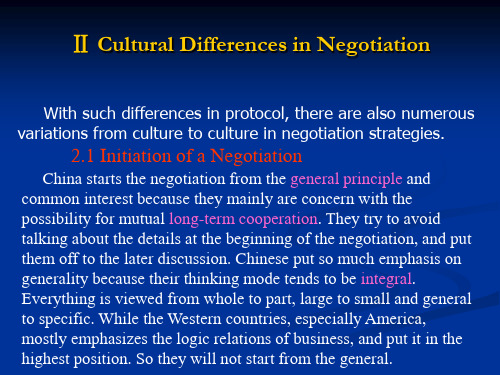
2.2 Emotion Style Versus Implement Style
Chinese are relationship-driven and consider the harmonious environment an important means for negotiation. Harmony is considered the precondition of stabilization, which is also true in business circle, as embodied in the saying “amiability begets riches”(和气生财). This kind of emotional tropism is also exemplified in other ways. Chinese try to avoid conflicts in negotiation and pursue a long-term and friendly partnership, i.e. if the deal is done, there will come a long lasting cooperation.
For the Americans, concession is an indispensable part of the strategy in concluding a contract, and it thus bears a positive meaning. But for the Chinese, concession is always negative, and they never concede on matter of principle, unless it is favorable for them.
我们应该怎样理解文化的不同英语作文
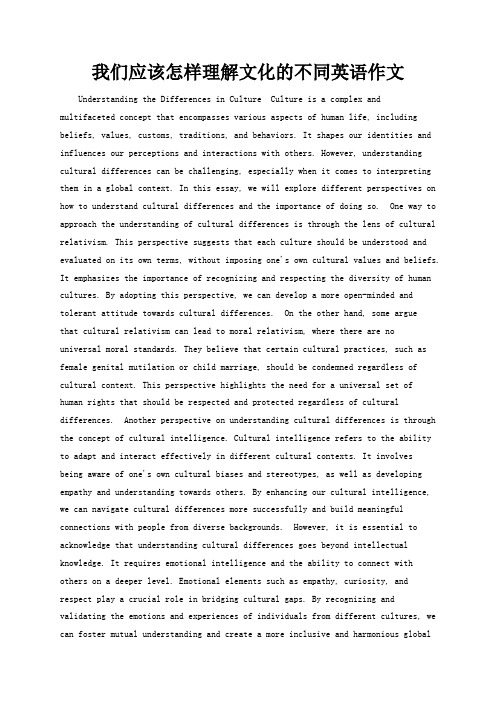
我们应该怎样理解文化的不同英语作文Understanding the Differences in Culture Culture is a complex andmultifaceted concept that encompasses various aspects of human life, including beliefs, values, customs, traditions, and behaviors. It shapes our identities and influences our perceptions and interactions with others. However, understanding cultural differences can be challenging, especially when it comes to interpreting them in a global context. In this essay, we will explore different perspectives on how to understand cultural differences and the importance of doing so. One way to approach the understanding of cultural differences is through the lens of cultural relativism. This perspective suggests that each culture should be understood and evaluated on its own terms, without imposing one's own cultural values and beliefs. It emphasizes the importance of recognizing and respecting the diversity of human cultures. By adopting this perspective, we can develop a more open-minded and tolerant attitude towards cultural differences. On the other hand, some arguethat cultural relativism can lead to moral relativism, where there are nouniversal moral standards. They believe that certain cultural practices, such as female genital mutilation or child marriage, should be condemned regardless of cultural context. This perspective highlights the need for a universal set of human rights that should be respected and protected regardless of cultural differences. Another perspective on understanding cultural differences is through the concept of cultural intelligence. Cultural intelligence refers to the ability to adapt and interact effectively in different cultural contexts. It involvesbeing aware of one's own cultural biases and stereotypes, as well as developing empathy and understanding towards others. By enhancing our cultural intelligence, we can navigate cultural differences more successfully and build meaningful connections with people from diverse backgrounds. However, it is essential to acknowledge that understanding cultural differences goes beyond intellectual knowledge. It requires emotional intelligence and the ability to connect with others on a deeper level. Emotional elements such as empathy, curiosity, and respect play a crucial role in bridging cultural gaps. By recognizing andvalidating the emotions and experiences of individuals from different cultures, we can foster mutual understanding and create a more inclusive and harmonious globalcommunity. Moreover, understanding cultural differences is not a one-time endeavor but a continuous learning process. It requires ongoing education and exposure to different cultures. This can be achieved through travel, intercultural exchanges, or simply engaging in conversations with people from diverse backgrounds. By actively seeking opportunities to learn about other cultures, we can broaden our perspectives and challenge our preconceived notions. In conclusion, understanding cultural differences is a complex and multifaceted task. It requires adopting a cultural relativist perspective while also recognizing the importance of universal human rights. Enhancing our cultural intelligence and emotional intelligence can help us navigate cultural differences more effectively. Furthermore, continuous learning and exposure to different cultures are essential in developing a more comprehensive understanding of cultural diversity. By embracing cultural differences, we can foster mutual understanding, respect, and appreciation, ultimately creating a more inclusive and harmonious world.。
从文化差异或跨文化交际程度写一篇英文作文
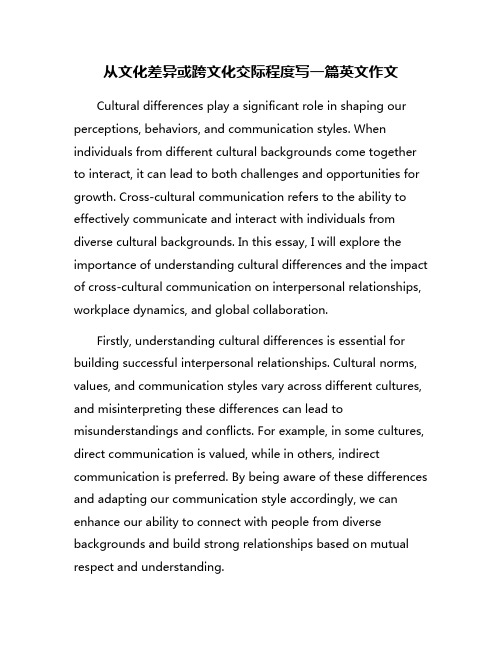
从文化差异或跨文化交际程度写一篇英文作文Cultural differences play a significant role in shaping our perceptions, behaviors, and communication styles. When individuals from different cultural backgrounds come together to interact, it can lead to both challenges and opportunities for growth. Cross-cultural communication refers to the ability to effectively communicate and interact with individuals from diverse cultural backgrounds. In this essay, I will explore the importance of understanding cultural differences and the impact of cross-cultural communication on interpersonal relationships, workplace dynamics, and global collaboration.Firstly, understanding cultural differences is essential for building successful interpersonal relationships. Cultural norms, values, and communication styles vary across different cultures, and misinterpreting these differences can lead to misunderstandings and conflicts. For example, in some cultures, direct communication is valued, while in others, indirect communication is preferred. By being aware of these differences and adapting our communication style accordingly, we can enhance our ability to connect with people from diverse backgrounds and build strong relationships based on mutual respect and understanding.Furthermore, cross-cultural communication plays a crucial role in the workplace, where individuals from various cultural backgrounds come together to collaborate on projects and achieve common goals. In a globalized world, organizations are increasingly diverse, with employees from different countries and cultural backgrounds working together. Effectivecross-cultural communication skills are essential for fostering a positive work environment, boosting creativity and innovation, and enhancing teamwork and collaboration. By promoting cultural sensitivity and inclusivity in the workplace, organizations can leverage the diverse perspectives and talents of their employees to drive success and achieve sustainable growth.In addition, cross-cultural communication is vital for promoting global collaboration and addressing complex global challenges. In today's interconnected world, countries and organizations must work together to tackle issues such as climate change, poverty, and pandemics. Effective cross-cultural communication is key to building partnerships, negotiating agreements, and aligning diverse stakeholders towards a common purpose. By fostering mutual understanding and empathy across cultural divides, we can create a more peaceful and harmonious world where people from differentbackgrounds can come together to create positive change and make a lasting impact.In conclusion, cultural differences have a profound impact on our perceptions, behaviors, and communication styles. By understanding and embracing these differences, we can enhance our ability to communicate effectively with individuals from diverse cultural backgrounds, build successful interpersonal relationships, foster a positive work environment, and promote global collaboration. Cross-cultural communication is a skill that is becoming increasingly important in our interconnected world, and by developing this skill, we can bridge cultural divides, promote mutual understanding, and create a more inclusive and harmonious society.。
cultural difference 英文解释

cultural difference 英文解释Cultural differences refer to the variations in beliefs, behaviors, customs, norms, and values between different cultures. These differences can arise due to a variety of factors, including historical, geographical, social, and economic influences. Understanding and respecting cultural differences is essential in promoting cross-cultural communication and cooperation.Cultural differences can manifest in various ways, such as language, communication styles, social norms, traditions, and etiquette. For example, greetings can vary significantly from culture to culture, with some cultures preferring a handshake, while others may opt for a bow or kiss on the cheek. Similarly, the concept of personal space and eye contact can differ among cultures, leading to misunderstandings and misinterpretations if not acknowledged.Moreover, cultural differences can also impact business practices, education, healthcare, and interpersonal relationships. In the business world, for instance, understanding the cultural nuances of your international partners or clients can be crucial for successful negotiations and collaborations. Different cultural perspectives on punctuality, hierarchy, decision-making, and conflict resolution can influence the way business deals are conducted.In education, cultural differences can influence teaching methods, learning styles, and classroom dynamics. Educators need to be aware of the cultural backgrounds of their students to create an inclusive and supportive learning environment. Similarly, healthcare providers must consider cultural beliefs, practices, and preferences when treating patients from diverse backgrounds to ensure effective and respectful care.Furthermore, cultural differences can shape societal values, attitudes, and behaviors, leading to misunderstandings, stereotypes, and discrimination. Recognizing and appreciating cultural diversity can help promote social harmony, inclusivity, and mutual respect. By celebrating cultural differences, societies can foster cultural exchange, creativity, and innovation.In conclusion, cultural differences are an inherent and enriching aspect of human societies. Embracing and understanding these differences can lead to greater cultural awareness, empathy, and interconnectedness. By acknowledging and respecting cultural diversity, we can build bridges, foster dialogue, and create a more harmonious and inclusive world.。
- 1、下载文档前请自行甄别文档内容的完整性,平台不提供额外的编辑、内容补充、找答案等附加服务。
- 2、"仅部分预览"的文档,不可在线预览部分如存在完整性等问题,可反馈申请退款(可完整预览的文档不适用该条件!)。
- 3、如文档侵犯您的权益,请联系客服反馈,我们会尽快为您处理(人工客服工作时间:9:00-18:30)。
口译中的文化差异及应对策略摘要:在跨文化商务交际中,东西方民族常常会因为文化积淀、认知方式以及思维方式的不同而遭遇文化冲突。
口译人员应自觉培养自身的跨文化意识,减少乃至消除商务谈判中的语用失误,促使跨文化交际的成功。
关键词:口译跨文化差异跨文化意识Cultural Differences in Interpreting and Coping TacticsAbstract: In cross-cultural business communication , east and west will often because national culture , cognitive styles and different ways of thinking and incurring the cultural conflict . Interpreter should be careful to develop their cross-cultural awareness , reduce or eliminate business negotiation of the pragmatic failures , make the success of cross-cultural communication .Key words: Interpretation Cross-cultural differences Cross-cultural awarenesswhen it comes to interpreters , we can not help thinking it an honored occupation , also , feeling that it is much far away from us . However , today we are learning the interpretation curriculum , which thanks to the good consequence of the transformation of the english lesson . I have not ever thought of that I could speak and listen english freely and fluently one day , but the interpretation curriculum may make it possible . Through the curriculum , I have learned how to make efficiency notes , which is much more different from and difficult than others, that's why we must form the style of notes charactered by ourselves . Being cool just as interpreter is not as easy as it looks like . Interpretation is a language communication behavior , which transforms one language to another , and a basic mode of communication that human beings of different culture and different ethnic are relying on . The job of interpretation is challenging , compared towritten translation , the most outstanding characteristic of interpretation is what you must say after a very short time . Interpreters have no time to think about it repeated deliberately or look up dictionary or reference book while interpreting . Sometimes interpreters may forecast to connected content according to the site condition ,but they ,in most of the time , cannot know the details ,especially in business negotiations . That demands interpreters not only know the language and the knowledge of business and industry , but also need to have a good command of the two kinds of culture and know about what are the differences between cultures on expression . For the time being , cross-cultural communication has become much more common in the globalization . Only knowing more cultural discrepancy , different habits , distinct way of thinking and different concept of diversity nationals , can they improve themselves of business interpretation step by step .The most difficulty the interpreter may encounter is the culture differences . We take it for granted that we are right if we do just as traditional of our country . For example , we eat with chopsticks while western foreign with spoon . That's the little difference but to the key point . We are familiar with Chinese and english interpretation ,because of the two languages belonging to oriental and westerner culture , the huge difference is apparent . Here , what I want to talk about is cross-cultural conflict caused by the diverse of cultural antecedents , cognitive system and thinking mode ,which are the main content in interpretation .Since Chinese has a long history ,accumulating plenty of old words , including idioms , proverbs , mottoes , slangs , saying , two-part allegorical sayings and so forth ,which contain abundant cultural connotation with thick national colors . For instance ,during a business activity , the Chinese side said ,'建立一条龙服务中心,为外国投资者提供审批业务', and the interpreter interpreted ,'set up the one-dragon service center to provide a coordinated process service for foreign investors in obtaining approval '. I don't think foreigners will understand . Moreover ,dragon represents auspicious in China while it means evil in western ,if interpreter does not know about it ,misunderstanding will occur .It is different of people's approaches and angles to sense and know the world around . Ina national or huge social groups ,the differences usually cannot be a barrier , however , when in different national , it can be . Even confronting with the same thing , people may form different words to express and you can not figure it out if you are not one of them . As an example in business negotiation interpretation , Chinese said ,'我们不会给你们打白条子,我们会按时付款的'. If the interpreter interpreters ,'we shall not issue blank paper to you , we will pay you on time '. Meanwhile ,foreigners cannot understand it . In fact , here blank means empty , or more straightforward , similar to IOU . The interpreter might as well interpreter ,' we shall not issue IOUS to you '. Foreigners can catch your main ideas .The last difference I will mention is the way of thinking , which summarize the objective reality and indirectly reflect using knowledge and experience as media . The way of thinking variety from one to another , determining the diversity of language expression . Therefore , we must adjust the language to others can understand and recept and it appears more fluently and natural . Or listeners may feel harder to understand . For example , there are a lot of special sentences differing from Chinese , which may cause a understanding gap . When 'it' as subject , it can represent time , place , distance , the name of lifeless words and a large passive situation ,all of these caused by national object strictly separate thinking characteristics . Many 'it' as form subject substitute for different forms of real subject and complicated , multi-level master-slave complex sentences are fear connected with the preference analysis thinking while Chinese prefer comprehensive thinking . British and American people used to talk about subjective views first and than object and last others connected , perhaps it is related to linear thinking while Chinese curve type thinking . Also , part or complete inversion can not be separated with reverse thinking .So it demands highly for interpreters to adapt themselves for better prompted know and communicate each other . Cultivate themselves cross-cultural quality is in a desperate time and armed with cross-cultural awareness . Interpreter should use intercultural knowledge to help business activities .Where there is a will , there is a way . Though interpretation is a tough occupation , we can do it better if we try our best . To me , I like english very much . I believe I willcontinue to learn english and interpretation to enrich my life .主要参考文献(限4篇以内):1.梅德明,2008,《中级口译教程》[M]。
